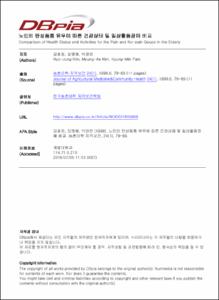노인의 만성 동통 유무에 따른 건강상태 및 일상활동장애 비교
- Keimyung Author(s)
- Kim, Myung Ae; Park, Kyung Min
- Department
- Dept. of Nursing (간호학)
- Journal Title
- 한국농촌의학회지
- Issued Date
- 1999
- Volume
- 24
- Issue
- 1
- Keyword
- The elderly; Chronic pain
- Abstract
- The purpose of this study is to compare health status and activities for the pain and no-pain groups in the elderly. The study subjects included 189 elderly people(65 years and older) living in an urban area. They were surveyed at their homes through interview using a closed-ended questionnaire from Nov. 6th. to Nov. 16th. 1997. The instrument used in the study was selected after carefully reviewing pain-related articles and records well described the characteristics of the elderly. The data were analysed by using descriptive statistics and chi-square tests. The findings were as follows :
Of the 189 subjects, 83.6% reported experiencing the pain for the last year. By the age, there were significant differences between the pain and no-pain group(χ2=9.572, p=.023). The percentage of the pain complainers was the highest in 80 years and older(100.0%), followed by 70~74(89.1%), 75~79(81.3%), 65~69(76.8%) which presented crude increase according to age. By sex, men had lower pain prevalence(69.5%) than that of women(90.0%). The number of pain complainers was higher in women than men(χ2=12.448, p=.023). There were significant differences between the pain and no-pain groups by spouse distribution(χ2=10.736, p=.001), educational state(χ2=13.020, p=.000), occupation(χ2=18.807, p=.000). Pain prevalence in the subjects having no spouse(59.3%) was higher than those having spouse(40.7%), Illiteracy rate was higher in pain group(49.0%) than no-pain group(13.3%). The number of the subjects having occupation(full time or part time) was fewer in pain group than no-pain group. By health status, there were significant differences between two groups(χ2=40.055, p=.000). : the pain group showed poor(61.4%), followed by moderate(22.1%), good(16.5%) while no-pain group showed good(64.5%), moderate(29.0%), poor(6.5%). By activities, there were significant differences between the pain and no-pain groups. The pain group was disturbed more severely than the no-pain group in movement(χ2=57.829, p=.000), sleep(χ2=12.785, p=.000), usual activities(χ2=39.196, p=.000), receiving guests(χ2=13.163, p=.000), and hobbies and recreation(χ2=28.177, p=.000).
- Alternative Title
- Comparison of Health Status and Activities for the Pain and No-pain Goups in the Elderly
- Publisher
- College of Nursing
- Citation
- 김효정 et al. (1999). 노인의 만성 동통 유무에 따른 건강상태 및 일상활동장애 비교. 한국농촌의학회지, 24(1), 79–89.
- Type
- Article
- ISSN
- 1225-634X
- Appears in Collections:
- 2. College of Nursing (간호대학) > Dept. of Nursing (간호학)
- 파일 목록
-
-
Download
 oak-bbb-05108.pdf
기타 데이터 / 1.01 MB / Adobe PDF
oak-bbb-05108.pdf
기타 데이터 / 1.01 MB / Adobe PDF
-
Items in Repository are protected by copyright, with all rights reserved, unless otherwise indicated.